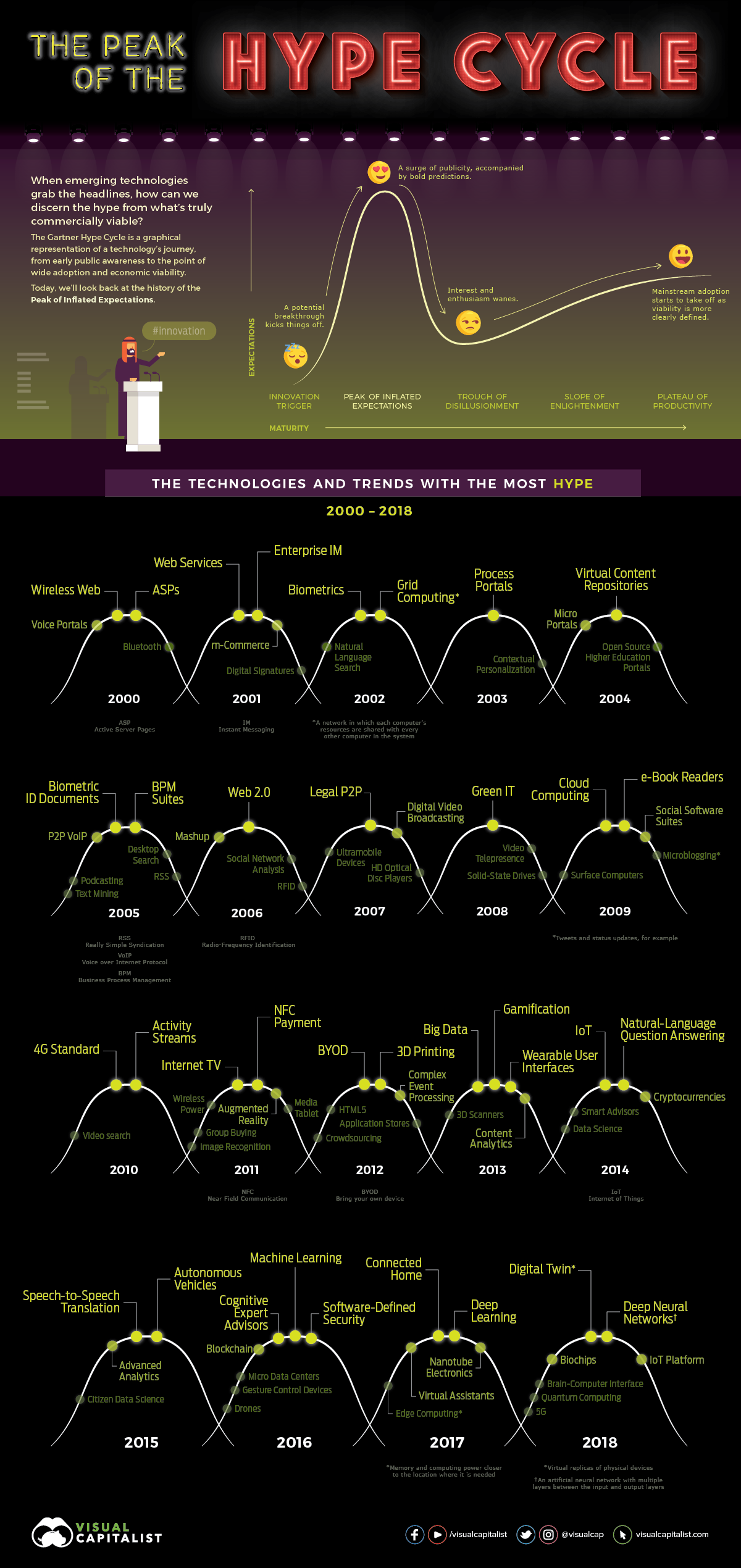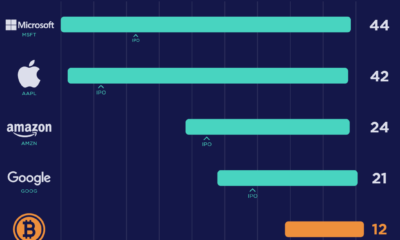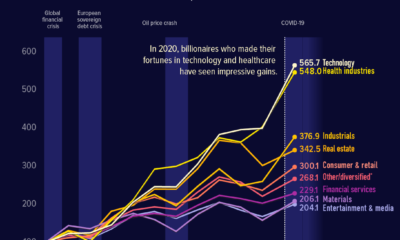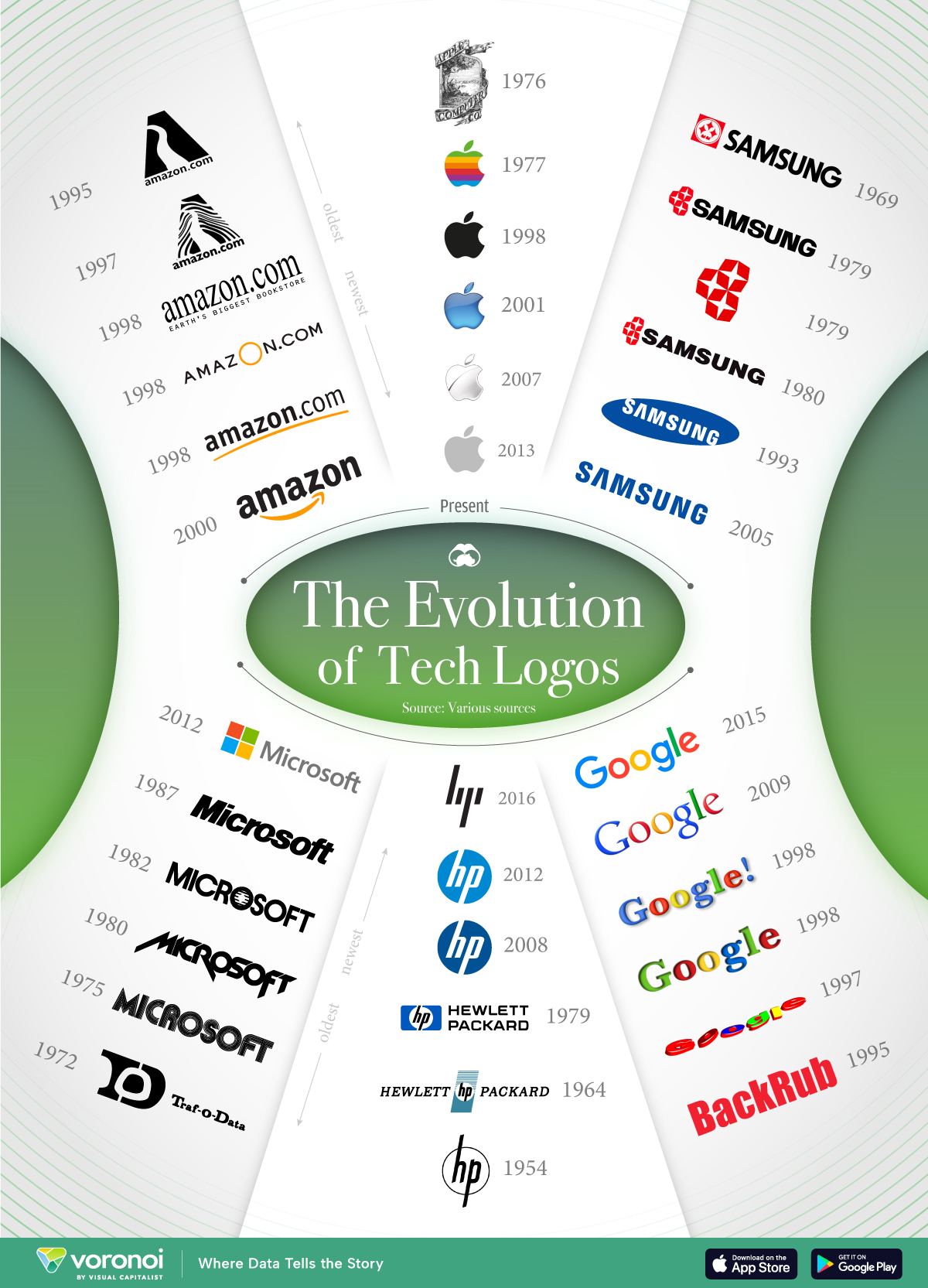Technology
The Most Hyped Technology of Every Year From 2000-2018

Visualizing Technology Hype Cycles (2000-2018)
Nothing captures our collective imagination quite like emerging technology.
In a short amount of time, technological innovations such as wireless internet and social networking have become a ubiquitous part of our everyday lives, quietly transforming the way we live, work, and communicate. Other promising technologies have their moment in the sun, only to fade into obscurity.
Gartner’s Hype Cycle charts the roller coaster ride of emerging tech, from the first stirrings of public awareness to the point of wider adoption and economic viability. Today’s graphic is a retrospective look at which trends scaled the summit of the Hype Cycle each year since 2000.
Reaching the Peak
As the media searches for the next big thing, certain technologies tend to dominate the headlines. Meanwhile, venture capital flows into the companies racing to bring the tech to market, valuations swell, marketing departments generate excitement, and the expectations of the general public begin to grow as well.
One example of this phenomenon at work is the adoption of microblogging. Today, we don’t think twice about posting a tweet or updating our status on Facebook, but a decade ago, the act of posting a short public message was major shift in the way people used technology to communicate with one another. The intense buzz that sent microblogging towards the top of the Hype Cycle is corroborated by Google Search data.

Living Up to the Hype
A few technologies transcend the hype to transform entire industries. Here are some examples that lived up to their time in the spotlight.
Cloud Computing
Right from the beginning, the analogy of data breaking the shackles of folders and clunky external drives – instead zipping efficiently into the invisible cloud – generated a lot of excitement. It felt like the future of computing, and enterprises and individuals eagerly adopted the technology.
Today, Microsoft and Amazon’s cloud computing divisions each make $6-7 billion in revenue per quarter, and that number is still growing at a brisk pace.
NFC Payments
Near Field Communication – the technology that enables contactless payments – is transforming the way people pay for purchases around the world.
The global contactless payments market is expected to reach $138.4 billion by 2023. Here’s a look at where NFC payments are making the greatest in-roads:

The Ones That Underwhelmed
During the Christmas season of 2009, Kindle became the most gifted item in Amazon’s history. This watershed moment looked like the end of physical books as the public embraced the e-reader as the new way of consuming text.
Fast-forward to today, and only 19% of adults in the U.S. own an e-reader.
Of course, not every technology that grabs the headlines is going to become the next iPhone. Here are some others that didn’t immediately meet expectations after topping the Hype Cycle.
m-Commerce
Some concepts fail primarily because they’re ahead of their time. Such is the case with mobile commerce.
By 2001, more than half of Americans owned mobile phones, and this represented a huge opportunity. Unfortunately, early m-commerce was restricted by the limitations of mobile phones of that time period. It wasn’t until the introduction of smartphones that the concept really took off. Today, nearly half of all online transactions are made via mobile devices.
3D Printing
Few technologies reach the fever pitch that 3D printing did in 2012. From the $1.4 billion merger of the largest players in the sector to the reports of firearm blueprints circulating the web, you could forgive people for believing that the 3D printer was destined to become the next microwave. In the end, interest in 3D printing leveled off.
While it is getting used for prototyping in many different industries, it remains to be seen whether the technology will ever achieve the wide consumer-level adoption that was promised.
What’s Next?
When 2019’s Hype Cycle is released later this year, it remains to be seen which technology will rise to the top. Based on the trajectory from last year, search volume, and current news reports, 5G is a strong competitor.
Brands
How Tech Logos Have Evolved Over Time
From complete overhauls to more subtle tweaks, these tech logos have had quite a journey. Featuring: Google, Apple, and more.

How Tech Logos Have Evolved Over Time
This was originally posted on our Voronoi app. Download the app for free on iOS or Android and discover incredible data-driven charts from a variety of trusted sources.
One would be hard-pressed to find a company that has never changed its logo. Granted, some brands—like Rolex, IBM, and Coca-Cola—tend to just have more minimalistic updates. But other companies undergo an entire identity change, thus necessitating a full overhaul.
In this graphic, we visualized the evolution of prominent tech companies’ logos over time. All of these brands ranked highly in a Q1 2024 YouGov study of America’s most famous tech brands. The logo changes are sourced from 1000logos.net.
How Many Times Has Google Changed Its Logo?
Google and Facebook share a 98% fame rating according to YouGov. But while Facebook’s rise was captured in The Social Network (2010), Google’s history tends to be a little less lionized in popular culture.
For example, Google was initially called “Backrub” because it analyzed “back links” to understand how important a website was. Since its founding, Google has undergone eight logo changes, finally settling on its current one in 2015.
| Company | Number of Logo Changes |
|---|---|
| 8 | |
| HP | 8 |
| Amazon | 6 |
| Microsoft | 6 |
| Samsung | 6 |
| Apple | 5* |
Note: *Includes color changes. Source: 1000Logos.net
Another fun origin story is Microsoft, which started off as Traf-O-Data, a traffic counter reading company that generated reports for traffic engineers. By 1975, the company was renamed. But it wasn’t until 2012 that Microsoft put the iconic Windows logo—still the most popular desktop operating system—alongside its name.
And then there’s Samsung, which started as a grocery trading store in 1938. Its pivot to electronics started in the 1970s with black and white television sets. For 55 years, the company kept some form of stars from its first logo, until 1993, when the iconic encircled blue Samsung logo debuted.
Finally, Apple’s first logo in 1976 featured Isaac Newton reading under a tree—moments before an apple fell on his head. Two years later, the iconic bitten apple logo would be designed at Steve Jobs’ behest, and it would take another two decades for it to go monochrome.
-

 Green1 week ago
Green1 week agoRanked: The Countries With the Most Air Pollution in 2023
-

 Automotive2 weeks ago
Automotive2 weeks agoAlmost Every EV Stock is Down After Q1 2024
-

 AI2 weeks ago
AI2 weeks agoThe Stock Performance of U.S. Chipmakers So Far in 2024
-

 Markets2 weeks ago
Markets2 weeks agoCharted: Big Four Market Share by S&P 500 Audits
-

 Real Estate2 weeks ago
Real Estate2 weeks agoRanked: The Most Valuable Housing Markets in America
-

 Money2 weeks ago
Money2 weeks agoWhich States Have the Highest Minimum Wage in America?
-

 AI2 weeks ago
AI2 weeks agoRanked: Semiconductor Companies by Industry Revenue Share
-

 Travel2 weeks ago
Travel2 weeks agoRanked: The World’s Top Flight Routes, by Revenue








